BOOK AN APPOINTMENT


Since the late 1800s, scientists and engineers have been fascinated with creating a genuine diamond in a laboratory, it was nothing more than a pipe dream, but until 1955 when General Electrics proved that it was finally possible to create a fully lab grown diamond. Nevertheless, these diamonds were far a far cry from the diamonds people were used to as they were small and of very low quality. Lab Grown diamonds would continue to be of inferior stock and unsellable for a further half-century, only finding use in an industrial setting. After the turn of the millennium, however, the technology needed to grow diamonds advanced so much that diamonds could be reliably grown and of high quality, rivalling mined diamonds.
In order to grow a diamond from the earth, incredibly high heat and pressure are required. The process takes thousands of years. A lab mimics those conditions but speeds up the process considerably to create a lab grown diamond.
Diamonds that are mined and those that are grown in a laboratory are indistinguishable from one another, even by experienced gemologists. This is because lab grown diamonds have the same molecular and chemical composition, as well as the same physical and optical properties, as mined diamonds. In contrast, simulated or imitation diamonds cannot be mistaken for the real thing. To understand what makes a diamond a diamond, it is helpful to know that it is made of pure carbon with a unique solid form. This form, known as a crystal, is one of several different types of solid carbon that can occur depending on the type of chemical bond, called an allotrope. Diamonds are made of the crystalline form of carbon, making them one of the few gems that are composed of a single element, usually around 99.95% carbon. The remaining 0.05% may include trace elements or atoms of other elements, such as boron and nitrogen, which do not affect the chemistry or structure of a diamond but can influence its shape or colour. Both mined, and lab grown diamonds may have these trace elements as a result of the processes involved in their creation, such as exposure to radiation.
The only difference, and a significant one at that, between lab grown diamonds in Hong Kong and mined diamonds, is the price. On average, lab-grown diamonds are an impressive 75% cheaper than mined diamonds. This price difference is not due to a lack of quality, as some misinformation online may suggest, but rather because the production of lab grown diamonds is competitive, unlike the monopolies that have historically controlled the mining of diamonds. To illustrate the magnitude of this price difference, consider that a mined diamond costing $10,000 might have a lab grown diamonds HK equivalent with the same characteristics and quality that costs around $3,000. This represents significant savings for customers.

The harsh reality of mined diamonds is that despite the convincing claims by the diamond companies, with reassuring terms as "clean origin" or "conflict free", the true origins of a mined diamond can never really be confirmed with any degree of certainty. It is inherently impossible to trace mined diamonds as it is with other pure elements such as copper and iron. On the contrary, a lab grown diamond can always be traced back to the source lab that created it. Ultimately, all claims to the contrary are merely marketing buzzwords aimed at misleading customers since earth-mined diamonds change hands at least 30-40 times between mining and sale.
The 4C grading system was initially developed by Robert M. Shipley, founder of the Gemmological Institute of America (GIA), and is used today to measure diamonds' colour, clarity, cut, and carat. As lab grown and mined diamonds are identical, they are graded using the exact same universal grading system, the 4Cs, using identical methods and tools. It is worth reiterating that lab grown diamonds and mined diamonds are identical except for their prices.
There is no difference between lab grown diamonds and mined diamonds when it comes to grading and certification. In terms of certification, there is absolutely no difference; you will find the same type of information in both certificates. "Laboratory-grown" or "laboratory-created" indications will only appear on the certificate of a lab created diamond for clarification purposes to differentiate them from mined diamonds.
Ethical versus Unethical is a topic dear to us and many others in the industry and beyond. This question is the fundamental reason why we chose to deal with lab grown exclusively and not mined diamonds.
As has been proven over and over again, diamond mining is harmful to the environment as well as to the people who work in the mines. The human cost of extracting a conflict diamond out of the ground is unfathomably enormous. Whole populations are displaced and harmed through the mining process, including miners, many of whom are enslaved people, their children, families, and the wider community. Even disregarding the human cost, mining for diamonds, or any stones for that matter, requires an unbelievable amount of earth to be cut open and sifted through. To give a rough idea of the scale of mining, a 1 carat of gem-quality diamond requires the digging up of 250 tonnes of dirt/ore. The destruction of so much habitable land and ecosystems is inevitable when a massive amount of soil needs to be blown up and dug up to find a single small stone.
There are other effects of mining besides the destruction of the earth. The mining process also requires a massive amount of energy, almost always exclusively derived from fossil fuels. The carbon emissions from this industry are immense and almost always underreported, if at all. In addition, a variety of toxic chemicals are continuously mixed with water, often from groundwater aquifers, for use in processing ores and cleaning gems like diamonds. The toxic slurry is then unceremoniously dumped on the previously fertile land, thereby all but guarantying soil contamination. Essential drinking water sources like a river or a pond and, more importantly, groundwater is rendered unfit for human or animal consumption. It is not surprising then that we take the debate of Ethical versus Unethical very seriously as a young and responsible company. Providing our customers with the most ethical and sustainable products is one of our core values; we cannot, under no circumstance, be involved in the destruction of the earth and its inhabitants.

"Rough to Retail" is a term that refers to the complete process of bringing a diamond from its initial state as a rough stone, whether it is mined or lab grown, to its final sale to an end customer in the retail market. The steps involved in the "Rough to Retail" process are the same for both mined and lab grown diamonds, including sorting, cutting, polishing, grading, and certification. There is no difference between the "Rough to Retail" process of mined and lab grown diamonds, as all of the intermediate steps and costs are identical.
There is one interesting fact to note: man made diamonds are typically better suited to ideal/excellent Cut grades than mined diamonds. Because mined diamonds come in all shapes and sizes, they are shaped/cut to maximise their yield as much as possible, prioritising ct weight above all else. By comparison, grown diamonds are cultivated to grow in a more ideal shape for cutting into gems, resulting in stones of superior cut grades without producing much waste.
